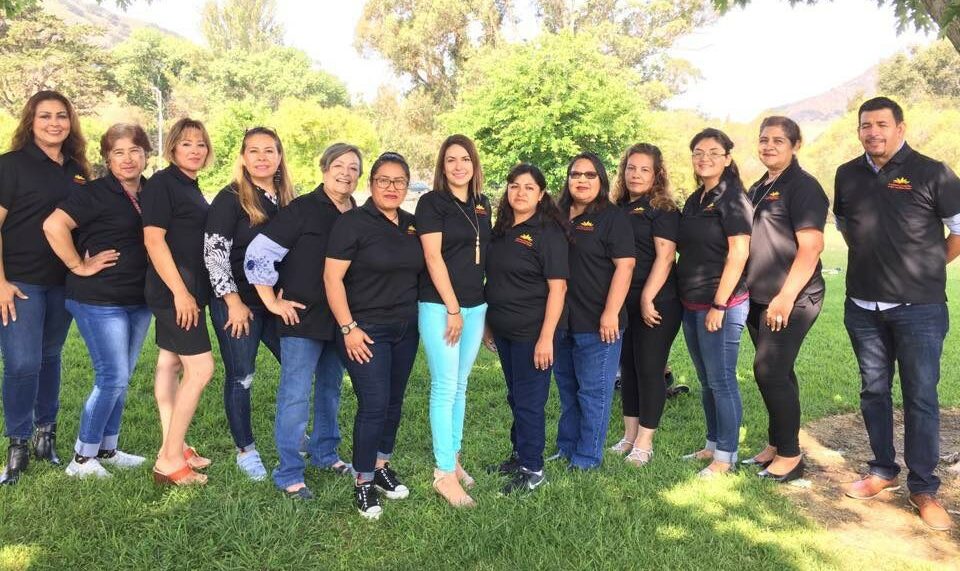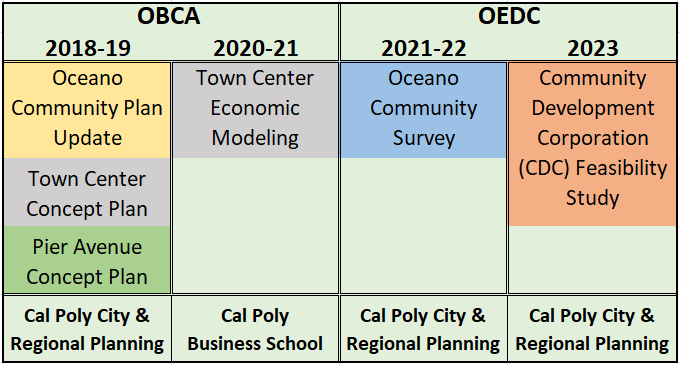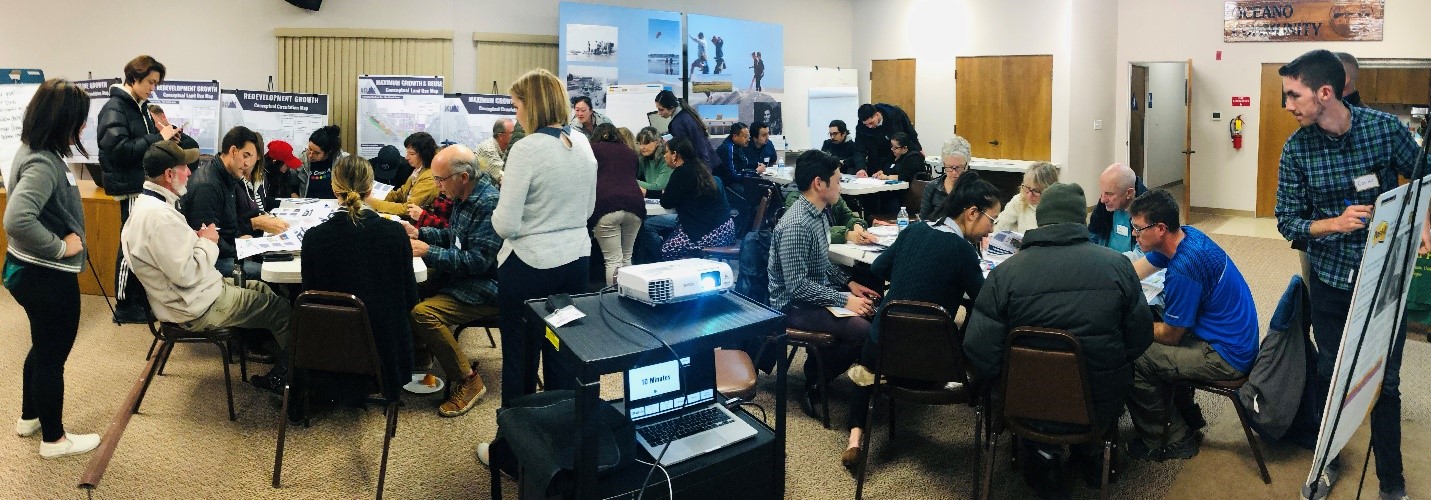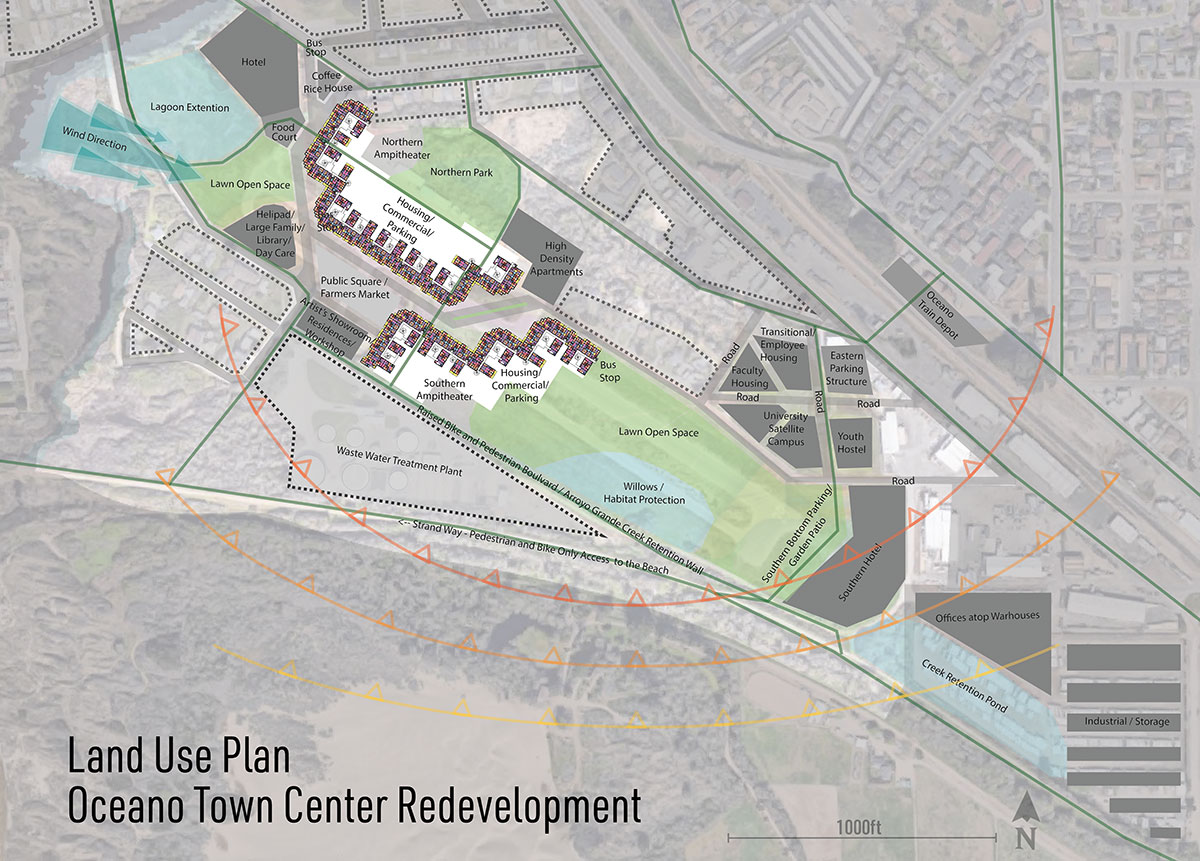CURRENT AFFILIATIONS
The Oceano redevelopment initiative was originally undertaken in 2018 under the aegis of the Oceano Beach Community Association (OBCA) https://oceanobeach.org/. In early 2021, the initiative separated from the OBCA to form the Oceano Economic Development Council (OEDC) as an independent nonprofit organization working with Cal Poly’s City & Regional Planning Department and Business School as well as other possible university departments in the future.
In addition to Cal Poly’s City and Regional Planning Department and Business School, the OEDC is working with the Promotores Collaborative of San Luis Obispo County https://cfsslo.org/promotoreslo/ whose director, Erica Ruvalcaba-Heredia, is now seated as one of the OEDC’s nine slated charter members. This is a vitally important working relationship for the OEDC to cultivate, with roughly half the Oceano’s population being Latino. The OEDC intends to engage as fully as possible with Oceano’s Latino community. On a related note, the Oceano Advisory Council’s Latina chair, Allene Villa, is also a charter OEDC member.

Promotores Collaborative of San Luis Obispo County
HISTORY AND CURRENT FOCUS

Building on accomplishments to date with Cal Poly’s City and Regional Planning Department and Business School, the OEDC is planning to proceed in 2024 with a study to determine the efficacy of creating a nonprofit Community Development Corporation (CDC).
The decision to explore the feasibility of a CDC strategy was based on results of a six-month community survey and was the consensus of the OEDC’s 25-member Project Advisory Committee (PAC).
Oceano Community Survey
An in-person, door-to-door community survey was conducted for the OEDC in January – June 2022 by bilingual graduate students in Cal Poly’s City and Regional Planning (CRP) program, building on four years of earlier studies not ed above. The survey garnered results from 275 of Oceano’s 2,636 households that had been sampled demographically to match 2020 census data.
Among the survey’s highlighted findings, respondents said they feel safe but want more sidewalks, new businesses, new job opportunities, and more affordable housing. They also want a town center that brings new outlets for dining and shopping, new cultural and community facilities such as a library and senior and youth centers, and recreational and sports facilities that include a soccer field and a recreational center. Full survey results can be found at https://oceanoedc.org/planning-development-documents/.
The survey process followed a “statistically representative sample method,” ensuring that results would be representative of community members’ opinions with a 95% level of confidence. Any survey questions that did not receive the required number of statistically significant response are labeled as such. The surveys were administered equitably throughout all Oceano neighborhoods. Respondents had the option of interacting with a native English speaker or a native Spanish speaker.
Survey responses are presented in a series of 54 slides many of which show the percentage of Latino and non-Latino respondents separately as well as combined. This was done for the express purpose of letting the Latino community know that their voices were heard. This has been an issue for many Latino residents who feel the Latino community has been disregarded and treated inequitably by the County.
The survey’s design was done jointly by Cal Poly faculty and students on the one hand and OEDC council members and advisors on the other. The process was overseen by AICP-certified planning professionals Chuck Stevenson (former division manager for the County’s long-range planning division and a former SLO City planning commissioner), and planning consultant Doreen Liberto, a former SLO County planning commissioner who owns Earth Design International, which specializes in land-use and environmental projects in disadvantaged communities. Also instrumental to its design was input from the OEDC’s 25-member Project Advisory Committee (PAC) which represents 15 Oceano stakeholder groups as listed on the OEDC website at https://oceanoedc.org/about-us/#pac.
Community Development Corporation (CDC) Feasibility Study
CDCs are 501(c)3 organizations controlled by community residents dedicated to the revitalization of underserved communities. CDCs engage in the planning and implementation of affordable housing, economic revitalization, small business development, capital improvements and other community development projects. They are also able to access unique sources of funding.
Hundreds of underserved communities around the country have formed CDCs. There are close to 100 in California alone. CDCs have built hundreds of thousands of affordable housing units nationally and created thousands of jobs through small business support and commercial revitalization.
Given the low funding priority the County has ascribed to Oceano over the years for community development, the OEDC believes the formation of a CDC presents the most promise for advancing the community’s future development based on priorities set by its residents as well as on regional socioeconomic benefits.
While the central focus of an Oceano CDC would be on Oceano’s development priorities, the CDC feasibility study would also address similar unmet needs in other underserved communities in the County. In doing so the study would reach out to and coordinate with other economic development initiatives in the County.
OCEANO REVITALIZATION INITIATIVE
2018 to Date
OEDC Roots
The OEDC is an outgrowth of an initiative begun by area residents who formed the Oceano Beach Community Association (OBCA) in February 2018 “to create positive change for Oceano.”
For decades Oceano has been in need of capital improvements while its infrastructure lapsed into a general state of disrepair and its economy suffered from a lack of jobs and stimulation. Multiple County studies and community plans were undertaken over the years offering residents hope and setting expectations for change, only to be discarded in the County’s ordering of its fiscal priorities. This has left many feeling left out and hopeless about Oceano’s future as well as distrustful of its governing authorities, especially among Latino community members, who make up half the town’s population.
In 2012 the State Legislature passed SB 535 which targets proceeds from the State’s Cap-and-Trade program for investment in disadvantaged communities through CalEPA. Then in 2015, the Legislature enacted the Clean Energy and Pollution Reduction Act (SB 350) to improve environmental and economic conditions in disadvantaged communities.
The State has defined the term “disadvantaged communities” to mean communities that have been “subjected to disproportionate impacts from one or more environmental hazards, socio-economic burdens, or both….and whose residents have been excluded in policy setting or decision-making processes and have lacked protections and benefits afforded to other communities.”
More specifically, the State has defined the term to mean census tracts where aggregated household incomes are less than 80% of area or state median income, which is the case with Oceano as determined by the California EPA’s screening tool for identifying disadvantaged communities.
As a disadvantaged community, Oceano was designated an Opportunity Zone by Governor Brown in April 2018, giving Oceanoans hope of attracting private capital for a comprehensive redevelopment initiative undertaken by area residents. Such an initiative would address key issues relating to land use, sea level rise and social justice along with jobs and housing.
Cal Poly Community Planning Workshops (2018-19)
With the aid of a community development advisor, OBCA representatives initially engaged with SLO County Planning on a community plan update for Oceano. Failing this due to County resource constraints, OBCA engaged with Cal Poly’s City & Regional Planning Department in two successive “planning studios” in which Cal Poly graduate students helped residents map out alternative futures for Oceano.
In a series of small community workshops led by Cal Poly CRP graduate students in the fall of 2018 and winter of 2019, Oceano residents voiced their aspirations for job creation, affordable housing and prosperity in their town, which has the highest rate of joblessness in the County. While only 30-40 community members participated in the workshops, the workshops quickly zeroed in on jobs and housing as key issues, especially among the Latino community which represents nearly half of Oceano’s population. This then prompted a series of projects in a follow-on planning studio in the spring of 2019.

2018 Cal Poly City & Regional Planning workshop with Oceano residents
In the first of these, CRP students met with residents in Oceano for a series of four workshops beginning in the fall of 2018, leading them progressively through a process that culminated in the preparation of a community plan update in March 2019: https://planforoceano.wixsite.com/oceano/8th-project.
Cal Poly Community Development Plans (2019)
The follow-on planning studio picked up where the first left off, with a series of projects that included two concept plans for beachfront developments along the lines of what Oceano’s town leaders had in mind back in the early 1900s when they aspired for Oceano to become a board-walked Atlantic City of the West with a town center near the seaside where the Oceano Airport is today. Aspects of the two concept plans were then assessed for their desirability and feasibility in a community-wide survey administered in 2022.

In 1917 this Town Center design was planned for the County’s present-day Oceano Airport
The two concept plans (referred to as specific plans below) establish models for the redevelopment of Pier Avenue as a visitor-serving business district, and the Oceano Airport as a town center, with a mix of commercial, residential, educational, and cultural/historical land uses.
- Pier Avenue Specific Plan. Pier Avenue presently serves as the vehicular entryway to the beach. This will no longer be the case after July 2022 if a recent Coastal Commission decision to close this entryway to vehicles is upheld by the courts, thereby enabling the redevelopment of Pier Avenue as a visitor-serving business district along the lines of a concept plan authored by graduate student Mark Pasanen: https://www.dropbox.com/s/nfcotuepcls1ksl/CRP%20%20PIER%20AVENUE%20SPECIFIC%20PLAN.pdf?dl=0.
- Oceano Airport Redevelopment Specific Plan. This 2019 concept plan envisions a vibrant, mixed-use development with an historic and cultural core west of Highway 1. The idea behind the project dates back to the early 1900s when town leaders mapped out and designed a town center at the site of the present-day airport. As presented below, the concept plan is meant solely for community assessment, not for implementation.
The original concept plan was updated in 2021-22 by architecture and finance students and is depicted below. Renamed the Oceano Town Center Redevelopment Plan, it imagines how the 60-acre Airport property could be repurposed to better meet Oceano’s needs and interests than as a general aviation airport. If Oceano is to grow and prosper with more job opportunities, cultural and recreational facilities, and affordable housing, it will need more land than is presently available for development. Only 3% of Oceano’s land is vacant and available for development. However, 13% of Oceano’s land is owned and controlled by the County as public land that could be re-purposed. The following rendering illustrates how the Airport could be repurposed as a cultural, recreational and commercial town center https://documentcloud.adobe.com/link/track?uri=urn%3Aaaid%3Ascds%3AUS%3A2e8287bd-f7ad-4b38-b307-5004c2b72709#pageNum=1

Land Use Concept Plan
Cal Poly Economic Modeling (2020-21)
Under the direction of a Cal Poly finance professor, Architecture and Business School students prepared an economic analysis of an Oceano town center concept plan. As mapped out above, the 65-acre plan would have 30 acres of open space and trails, 12 types of residential housing (much of it affordable housing), more than 350,000 square feet of commercial space, 200,000 square feet of hospitality and community facilities, 350,000 square feet of education and historic facilities, and 150,000 square feet of parking space. The economic analysis projected estimates for new jobs, new housing units, and incremental income for the County.
Oceano Community-Wide Survey (2022)
This economic modeling was used to inform a community-wide land-use study with Oceano residents, asking about the kind and mix of redevelopment they’d like to see, while showing them what might be possible in terms of job creation, housing and improved living conditions.
The sole purpose of the design modeling and economic modeling being done for the Pier Avenue and Town Center concept plans was to assess prospects for redevelopment, not to promote any particular model or even these specific ideas for redevelopment.
Pier Avenue Public Plaza Design Study (2021-22)
While the OEDC is chiefly concerned with Oceano’s long-range prospects for business development, it is now exploring more immediate ways to stimulate business activity by attracting more pedestrian business on Pier Avenue to offset the anticipated loss of the off-roader business occasioned by the Coastal Commission’s March 2021 decision to close Pier Avenue as a vehicular entrance to the beach by July 2022.

Example of a Pismo Beach cul-de-sac with no beach entryway,
public plaza or boardwalk connection
1906 Oceano Town Center Vision
Plans for an Oceano town center date back more than a hundred years, siting its development near the beach on the present-day Oceano Airport property. A subdivision map for the development features a brick fountain centered in a park surrounded by shops and dwelling units.

Oceano Town Center
Subdivision Map
As far back as 1906 the town aspired to become a visitor-serving tourist attraction, with the Oceano Chamber of Commerce dubbing the town the Atlantic City of the West in the 1920s.
Over the years the dream of becoming a booming tourist town faded under the County’s reluctance to implement community plans and much-needed capital improvements (as documented below), and with the State’s 1982 permitting of recreational driving on Oceano’s beachfront, even as neighboring Grover Beach and Pismo Beach flourished with their vehicle-free beaches.

Horse and buggy beachfront activity in front of the La Grande Pavilion ca. 1905
Recreational driving on Pismo State Beach and in the Dunes became commonplace as far back as the early 1900s. Dune buggies came along in the mid 1900s, followed in more recent years by ATVs and RVs along with the throngs of street-legal cars and trucks we see today.
Interestingly, the County has never explored what the economic prospects might be for Oceano and the County if Oceano were to become a visitor-serving beach community, especially given its unmatched shoreline and dunes; its unique Dunite history of art, photography and literature; its rich cultural diversity, and its agricultural roots. Many residents wonder about it, especially in the Latino community.
The Latino Outreach Council took notice of it at a general membership meeting in 2014 when it gave this slide presentation entitled, Oceano 20th-21st Century: https://www.dropbox.com/s/h9nlo49uxxcefff/LOC%20-%20Oceano%2020th 21st%20Century%20Powerpoint%208-28-14.pdf?dl=0.
